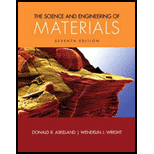
Effect on toughness of alumina matrix on embedding SiC fibers.
Answer to Problem 7.1P
Toughness of the ceramic matrix composite gets enhanced/increased.
Explanation of Solution
When a material comprises of two or more other materials at a "microscopic" level/scale such that they have distinct chemically phases, the material is termed as Composite material. The "constituent materials" of a composite have different properties which results in an enhanced property for composite material.
The Silicon carbide (SiC) fibres have high values of specific strength, specific modulus and temperature resistance, corrosion resistance. Toughness of a composite is dependent on the deflection of crack at the interface.
Now,when theSiC fibers are reinforced in the alumina matrix the crack in the substrate (alumina)does not pass through the SiC whisker/fiber and it expands by bypassing the SiC whiskers,which lead crack deflection. It occurs as the SiC whisker have high strength modulus and hence more energy is required to propagate a crack through the composite. Hence, it leads to high toughness of the SiC embedded alumina composite.
Want to see more full solutions like this?
Chapter 7 Solutions
The Science and Engineering of Materials (MindTap Course List)
- Estimate the linear relationship between the Ultimate Tensile Strength and HBN for the range of brass alloy shown in Figure 4b (ii).arrow_forwardDraw a load vs. displacement curve as obtained from a homogeneous material using nanoindentation. Please explain how the elastic modulus is calculated using the curve.arrow_forwardA form of boron nitride (BN) known as hexagonal boron nitride is used as a solid lubricant. Explain how this may be possible by comparing this situation with that encountered in two forms of carbon, namely diamond and graphite.arrow_forward
- Calculate the typical relaxation time for silicate glassand comment on its propensity for stress relaxation at roomtemperature. E ~ 70 GPa and η ~ 1 x 1012 GPa-s (1022poise).arrow_forwardA sample of an aluminum alloy has a tensile strength of 140 MPa,What will be the maximum force that can be withstood by a rod of thatalloy with a cross-sectional area of 1 cm2?arrow_forwardAluminium has a density of 2.7 g/cm3. Suppose you would like to produce a composite material based onaluminium having a density of 1.5 g/cm3. Design a material that would have this densityarrow_forward
- The yield point for a brass alloy that has an average grain diameter of 50 micrometers is 120 MPa.arrow_forward9.6 Briefly explain (a) why there may be sig nificant scatter in the fracture strength for some given ceramic material, and (b) why fracture strength increases with decreasing Y lo specimen size.arrow_forwardFrom list of the materials in the table above, please explain : 1. Which material has the greatest elongation? Explain your reason. 2. Which material has the highest strength? Explain your reason. 3. Which the most brittle material? Explain your reason. 4. Which the most rigid material? Explain your reason. 5. Which materials are most easily deforms plastically? Explain your reason. 6. If the material with cylinder form has a diameter of 10 mm and loaded with a mass of 2600 kg as shown in the picture above. -Which material you choose for cylinder to be able to withstand the load and will not have the permanent extension? -Which material is used, if the cylinder diameter will have a permanent reduction? -Which material is used, if the cylinder will fail?arrow_forward
- What is the material used for the wire BC? Justify your answerarrow_forwardWhen a failure data set for a ceramic material processed in a certain facility is analyzed, it is found that the characteristic strength is 327 MPa and the Weibull modulus is 8.75. A nominally identical batch of material processed in a different facility is also tested and found to have essentially the same characteristic strength, but the Weibull modulus is 6.25. At what stress level is the probability of failure equal to 50% for each set of material? What initial conclusion might you draw about the quality control procedures at the two facilities?arrow_forwardHow do the principal metallic crystal structures, including body-centered cubic (BCC), face-centered cubic (FCC), and hexagonal close-packed (HCP), play a pivotal role in shaping the mechanical properties of materials, and how does the practice of crystal structure analysis provide valuable insights into the behavior and performance of these materials within the realm of mechanical engineering?arrow_forward
 Elements Of ElectromagneticsMechanical EngineeringISBN:9780190698614Author:Sadiku, Matthew N. O.Publisher:Oxford University Press
Elements Of ElectromagneticsMechanical EngineeringISBN:9780190698614Author:Sadiku, Matthew N. O.Publisher:Oxford University Press Mechanics of Materials (10th Edition)Mechanical EngineeringISBN:9780134319650Author:Russell C. HibbelerPublisher:PEARSON
Mechanics of Materials (10th Edition)Mechanical EngineeringISBN:9780134319650Author:Russell C. HibbelerPublisher:PEARSON Thermodynamics: An Engineering ApproachMechanical EngineeringISBN:9781259822674Author:Yunus A. Cengel Dr., Michael A. BolesPublisher:McGraw-Hill Education
Thermodynamics: An Engineering ApproachMechanical EngineeringISBN:9781259822674Author:Yunus A. Cengel Dr., Michael A. BolesPublisher:McGraw-Hill Education Control Systems EngineeringMechanical EngineeringISBN:9781118170519Author:Norman S. NisePublisher:WILEY
Control Systems EngineeringMechanical EngineeringISBN:9781118170519Author:Norman S. NisePublisher:WILEY Mechanics of Materials (MindTap Course List)Mechanical EngineeringISBN:9781337093347Author:Barry J. Goodno, James M. GerePublisher:Cengage Learning
Mechanics of Materials (MindTap Course List)Mechanical EngineeringISBN:9781337093347Author:Barry J. Goodno, James M. GerePublisher:Cengage Learning Engineering Mechanics: StaticsMechanical EngineeringISBN:9781118807330Author:James L. Meriam, L. G. Kraige, J. N. BoltonPublisher:WILEY
Engineering Mechanics: StaticsMechanical EngineeringISBN:9781118807330Author:James L. Meriam, L. G. Kraige, J. N. BoltonPublisher:WILEY





